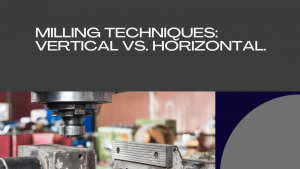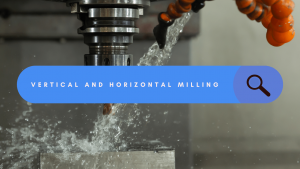Het freesproces is een bewerkingsproces dat over het algemeen gebeurt wanneer roterende snijders worden gebruikt om materiaal uit een werkstuk te verwijderen. Het is een vage techniek die wordt gebruikt om verschillende vormen en maten te maken. Als het gaat om frezen, Er zijn twee hoofdmethoden: bewerkingsprocessen, zoals verticale frezen, en horizontaal frezen. Het selecteren van de meest geschikte methode voor uw project hier is een kwestie van het grootste belang, omdat het uiteindelijk kan beïnvloeden hoe de algehele output eruit zal zien en de operatie zelf.
Inzicht in de verschillen tussen verticale en horizontale frezen
Verticaal frezen is de naam voor de freesmachine, die de spil heeft op de verticale as. Het is het geval dat de tool zich verticaal boven het werkstuk in dit proces bevindt. Daarentegen, Horizontaal frezen wordt gedefinieerd als de freesmachine die de spindelas horizontaal geplaatst draagt. Voor deze toepassing, Het snijgereedschap wordt horizontaal gehouden, over het werkstuk.

Als het gaat om het verschil tussen verticale en horizontale frezen, Er zijn een aantal factoren waarmee rekening moet worden gehouden. De oriëntatie van de spindelas bepaalt de richting van het gereedschap dat het werkstuk in eerste instantie nadert. In verticaal frezen, De tool reist naar beneden in het werkstuk; anderzijds, in horizontale frezen, Het gereedschap glijdt zijwaarts over het werkstuk. Allereerst, Verticale freesmachines zijn meestal gespecialiseerd in het omgaan met kleine, Meer gecompliceerde taken, Terwijl horizontale freesmachines nuttiger zijn voor groot, koppige taken.
Voor- en nadelen van verticale frezen
Er zijn veel voordelen aan verticale frezen. Eerst, Het zorgt voor snelle en gemakkelijke toegang tot het werkstuk, die geschikt is voor nauwkeurige sneden, Bijvoorbeeld van artistieke projecten. Daarnaast, De meeste verticale freesmachines zijn bovendien voorzien van digitale uitlezingen en stroomfeeds, die een hogere mate van nauwkeurigheid en efficiëntie bieden. Ze komen ook van pas in het besparen van ruimte en zijn vrij betaalbaar in vergelijking met horizontale freesmachines.
Aanvullend, Het verticale frezen is ook niet onberispelijk. Een belangrijk nadeel is dat het lang kan duren om het grootste deel van het materiaal te snijden, omdat de lagere kracht het snijgereedschap uitoefent. In aanvulling, De verticale freesmachines passen niet goed voor zware taken die een hoog koppel en vermogen nodig hebben. Echter, Een nadeel van deze machine is de verticale oriëntatie van de spindelas die het moeilijk kan maken om grote werkstukken te malen.
Voor- en nadelen van horizontaal frezen
Echter, Horizontaal frezen heeft ook eigen voordelen. Daarom, het helpt de verwijdering van overmatige hoeveelheden materiaal op een snelle en precieze manier. Dit is een voordeel voor zware toepassingen die een hoog koppel en sterk vermogen vereisen. Daarnaast, Horizontale freesmachines hebben waarschijnlijk automatische toolwisselaars, die zorgen voor een soepele en snelle wijziging van gereedschap. In aanvulling, Horizontale freesmachines kunnen taken uitvoeren op grotere werkstukken, Omdat ze horizontaal zijn gericht.
Er zijn enkele nadelen aan dit specifieke proces. Een van de grootste problemen is dat het moeilijker is om nauwkeurige incisies en fijne ontwerpen te maken, Op welke verticale frezen is beter in. Het andere is dat horizontale freesmachines meer omvangrijk zijn, duur en neem grotere hoeveelheden ruimte in vergelijking met verticale freesmachines. Eindelijk, de vorm van de spilas, samen met de horizontale, is een reden voor de moeilijkheden bij de opstelling van de werkplek voor installatie en service.
Factoren om te overwegen bij het kiezen tussen verticale en horizontale frezen
Bij het nadenken tussen verticale en horizontale frezen, Er moeten rekening worden gehouden met verschillende variabelen. Allereerst, De aard van het gemalen materiaal is een belangrijke factor om te overwegen. Sommige materialen kunnen worden gebruikt op een verticale maalmachine, terwijl anderen mogelijk horizontale freesfuncties nodig hebben. Ook, De projectgrootte en de complexiteit ervan moeten worden gerealiseerd. Kleiner, Ingewikkelde projecten kunnen beter worden geserveerd met verticale freesmachines, terwijl groter, Over het algemeen kunnen zware duty's beter worden vervuld door horizontale freesmachines.
Bovendien, De problemen van prijs en beschikbaarheid van de apparatuur moeten ook in aanmerking worden genomen. Verticale freesmachines (VM's) zijn vaak goedkoper en eenvoudiger te verkrijgen in vergelijking met horizontale freesmachines (Hm). Aan de andere kant, Als uw taak de functies van een horizontaal maalapparaat vereist, Het is waarschijnlijk dat u ondanks het feit de hogere prijs zult compenseren. Daarnaast, Het vaardigheidsniveau van de operator moet in aanmerking worden genomen. Met betrekking tot verticale freesmachines, zijn meestal operatorvriendelijker en vraag om minder vaardigheden. Aan de andere kant, Horizontale freesmachines vereisen meer ervaring en expertise.
Toepassingen van verticale en horizontale frezen
Verticaal frezen is een van de meest voorkomende operaties die op grote schaal worden gebruikt in de ruimtevaartuigen, auto, en elektronische productie -industrie. Het heeft zeer goed gepresteerd in projecten met ontwerpen die zeer complex zijn en bezuinigingen die zeer nauwkeurig zijn. De toepassingen in de industrie zijn te realiseren door het creëren van schimmels, sterven, en kleine delen.

Vergeleken met verticale frezen, die de toepassing ervan voornamelijk op medisch gebied heeft gevonden, horizontaal frezen wordt vaker gebruikt in de constructie, fabricage, en zware machinesindustrie. Het is beter voor sloopwerken die snel moeten worden gedaan en die veel puin produceren. Naarmate toepassingen zich manifesteren bij de productie van versnellingen, schachten, en andere grote componenten zijn een van de voorbeelden.
Welke freesmethode is het beste voor u?
Tenslotte, Het kiezen van de juiste freesmethode voor uw werk is van vitaal belang. Verticaal en horizontaal frezen genieten van hun eigen verdiensten en verlang, en elk van hen heeft zijn eigen waarden. Aspecten van frezen zoals het materiaaltype, Projectgrootte en complexiteit, Prijs van de apparatuur, en het vaardigheidsniveau van de operator moet worden overwogen.
Als u aan een ingewikkeld project gaat werken en meer nauwkeurige bezuinigingen nodig hebt, Verticaal frezen kan worden gezegd dat het de perfecte optie voor u is. Enerzijds, Als u in korte tijd een grote hoeveelheid materiaal moet snijden met een hoge efficiëntie, dan kan horizontaal frezen geschikter zijn. Op het einde, De keuze moet worden bepaald door uw specifieke project of sector die de specifieke behoeften vereist.
